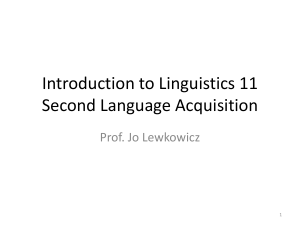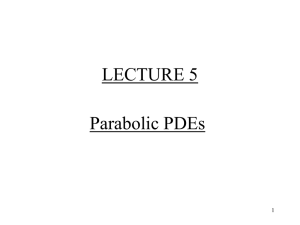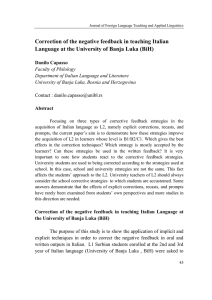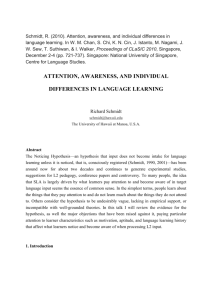sla_tesol_2011 (3)
advertisement
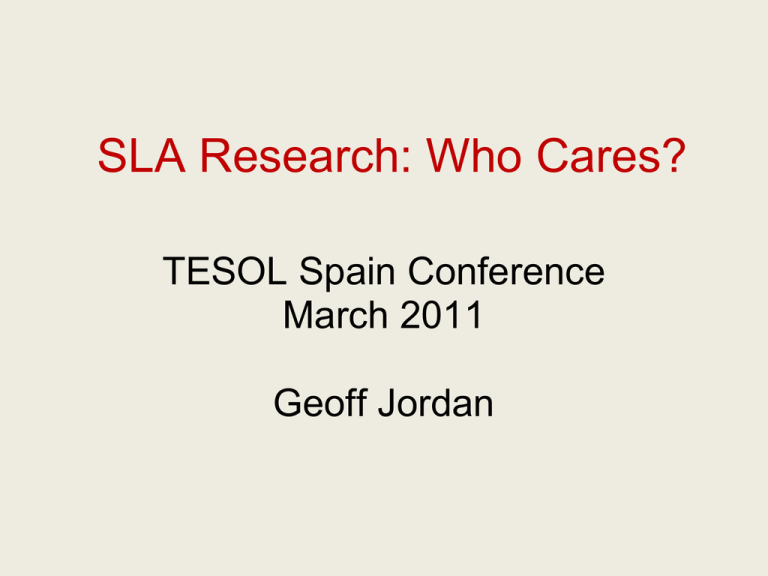
SLA Research: Who Cares? TESOL Spain Conference March 2011 Geoff Jordan Do You Agree? • Krashen is right: acquisition and learning are essentially different. Yes No • Explicit grammar teaching is a waste of time. Yes No Beyond Krashen: Cognitive Processing • SLA = Cognitive process by which linguistic skills become automatic. • At first, processes need attention. With practice, they become automatic. • The process results in the restructuring of the existing mental representation. • Key Constructs: o o o Interlanguage; Implicit/explicit knowledge Acquisition/learning McLaughlin: Automaticity and Restructuring • Controlled processing requires attention; automatic processing does not. • Automaticity: an associative connection between input and output. • Analogy: driving a car with a clutch. • Restructuring: a qualitative change in the learer's interlanguage. "U-shaped bevaviour" (Wotcha gonna hav?). Long’s Interaction Hypothesis • The negotiation of meaning (repeat, confirm, clarify, check, re-cast, etc.) helps to make input comprehensible. • For input -> intake, learner must focus on form (which negotiation of meaning helps). • Swain: Canadian immersion learners showed that input not enough. Learners need comprehensible output. Long: Problems of Instructed SLA Problem 1. Purely implicit child L1A is overwhelmingly successful L1 learning during first 6 years takes place • Implicitly, without intention, incidentally: while focused on something else. • Without awareness of the process or of the end-product. ….but purely implicit adult L2A is highly variable and largely unsuccessful Prolonged immersion in L2 environment without formal instruction results in: 1.limited functional communicative abilities in most cases, 2.near-native communicative abilities in only a tiny minority of cases, 3.never, as far as we know, native-like abilities. Solution 1: Adult SLA is maturationally constrained. Research findings suggest early closure of sensitive periods: • native-like phonology: 6 to 12. • lexis and collocations: 6 to 10 • morphology and syntax: 14 Solution 1a: Adults are partially ‘disabled’ language learners • Adults use entrenched L1 processing habits for L2 processing. • Unless “re-set” by explicit learning or teaching, implicit processing tuned for L1 will filter the L2 through the L1 grid. • Result: some differences perceived are as unimportant, others are completely missed. • See “Developmental sharpening.” (Cutler, 2001). Problem 2: Some linguistic features in adult SLA are fragile Adult starters’ failures are not random. “Fragile” features = non-salient and low perceptual saliency. Infrequent, irregular, non-syllabic, string-internal, semantically empty, and communicatively redundant. Solution 2: Explicit learning is required to improve implicit processing. • Implicit learning is still the default learning mechanism in adult SLA. • So non-salient features not learned. • Explicit learning: a new form-meaning connection is held in s-t memory so it can be processed, rehearsed, and an initial representation stored in l-t memory, thus altering future implicit processing of additional exemplars of the item concerned in the input. Explicit Knowledge facilitates Implicit Knowledge…. ….by helping the learner to modify entrenched automatic L1 processing routines, so as to alter the way that subsequent L2 input is processed implicitly. " Changing the cues that learners focus on in their language processing changes what their implicit learning processes tune." (Ellis, N. 2005) Pedagogical Implications of SLA Research: What Do You Think? • How does L1 affect learning L2? • Which is more helpful: comprehension or production? • Is explicit grammar instruction helpful? • Does error correction help? • Can you teach pronunciation? • How can “fossilization” be overcome? The influence of L1 • • • • It’a big influence, but it's complex. “Spanglish” is a commonplace. Pronunciation is affected. But it’s not predictable, and can be misleading. • Interlanguage development is the key. Comprehension or Production? • Comprehensible input is a necessary but not a sufficient condition. • Massive reading (TAVI not TALO) is very important, and so is extensive listening. • Interaction helps comprehension (teacher talk - minimise L1). • Learners need to control information, and interact using meaningful content. • Drills are OK. • Writing: increasingly important. Role of explicit grammar instruction • Pienemann et. al: you can influence rate, but not route. • Focus on Form vs. Focus on FormS (FoF = Intergration of form and meaning: TBLT.) • "Input enhancement": make the input more noticeable. • "Input flood": learners are exposed to vast quantities of a given structure. Does error correction work? • Errors indicate learners’ hypotheses about L2. Overt correction can’t alter natural path. • Classroom correction is highly diverse and little studied. • Correction must bring students’ attention to their own errors, and do so in meaningful, communicative contexts. • Face Value Can you teach pronunciation? • The most important variables are the ones teachers have the least influence on: L1, aptitude for oral mimicry, motivation & attitude • Research shows that accurate pronunciation is an unrealistic goal and over-valued as a measure of proficiency How can we help learners who seem to have reached a plateau? • What are the causes? Lack of integration? neurological constraints of mature learners? the communicative approach?, ....? • Writing • Grammar-based materials • Collocation & discourse instruction • ESP Conclusion • SLA theory still very incomplete. • More classroom-based research needed. • An experienced teacher “knows” more than even the best researcher.




